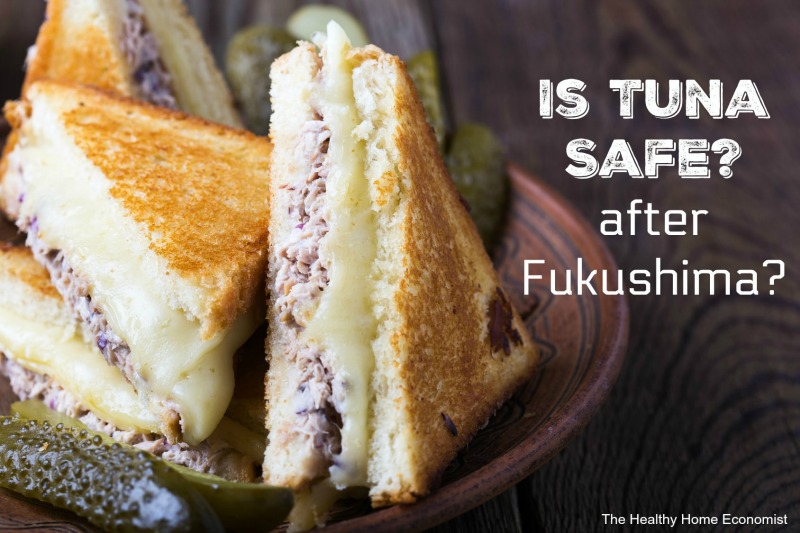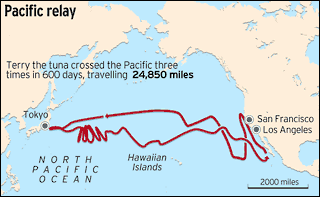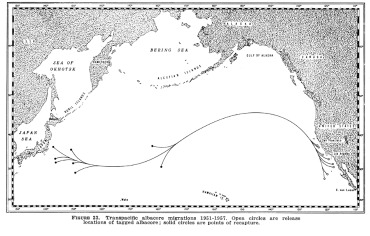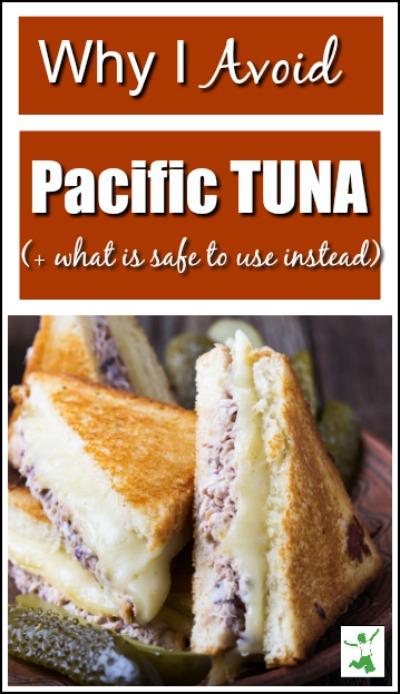
Tuna has always been a staple Real Food in our home. I’ve always taken care to source low mercury, sustainably caught tuna in order to prepare quality tuna steaks for dinner, tuna melts for lunch, or that old standby tuna salad for lunch boxes, quick snacks or just a dollop on a bed of greens. Spicy bluefin tuna rolls are a favorite of my husband when dining at Japanese restaurants.
About a year ago, however, I started to question my choice of tuna for regular consumption. I began reading the reports about the spreading radiation plume in the Pacific from the continuing Fukushima nuclear disaster. I delved into the migratory patterns of various species of tuna. The more I read, the more concerned, and quite frankly, confused I became.
Realizing that my family’s health can’t be wagered on guesses or half-truths, I gathered as much information as I could to arrive at an informed decision. Here’s what I found.
All species of tuna are highly migratory. This means that they swim long distances pretty much throughout their entire lives. These migration patterns are still ill-understood although it is generally agreed upon that they are large.

Pacific bluefin tuna are born near Japan spending their early months swimming in the radiation plume there. They then swim back and forth across the Pacific their entire lives. One tuna nicknamed Terry crossed the Pacific no less than 3 times in the span of only 20 months coming very close to Japan each time. To the right is a chart showing his epic swim.
The information gleaned from Terry the tuna is not new. As early as the 1950’s, tagged albacore tuna were known to swim thousands of miles as shown in this second chart to the right. The open circles off the California coast indicate where they were released and the solid circles closer to Japan indicates where they were recaptured.
 Highly migratory indeed!
Highly migratory indeed!
Atlantic based tuna exhibit the same nomadic patterns. According to National Geographic, high tech tags of Atlantic bluefin tuna revealed the following:
A team of international scientists documented two giant bluefins tagged within minutes of each other off the coast of Ireland. The two fish swam to opposite sides of the Atlantic Ocean–ending up more than 3,000 miles (5,000 kilometers) apart. One of the fish traveled 3,730 miles (6,000 kilometers) southwest to waters about 186 miles (300 kilometers) northeast of Cuba. The other remained in the eastern Atlantic and moved off the coasts of Portugal.
According to the Food and Agriculture Organization of the United Nation (FAO)s, all species of tuna, not just bluefin and albacore, are considered highly migratory, again with the reasons for these patterns not well understood. Here is a breakdown of the tuna species and where they are located according to a report by the FAO:
- Albacore tuna (Thunnus alalunga), which occurs in tropical and temperate waters worldwide.
- Bluefin tuna (Thunnus thynnus), mostly found in temperate waters of the Atlantic, including the Mediterranean, and Pacific Oceans. It is noted that since the adoption of UNCLOS, bluefin tuna in the northern Pacific has been identified as a different species, Pacific bluefin tuna (Thunnus orientalis) while bluefin in the Atlantic has been re-named Atlantic bluefin tuna.
- Bigeye tuna (Thunnus obesus), found in the Atlantic (but absent from the Mediterranean), Indian and Pacific Oceans.
- Skipjack tuna (Katsuwonus pelamis) with a worldwide distribution in tropical and temperate waters.
- Yellowfin tuna (Thunnus albacares), also with a worldwide distribution in tropical and sub-tropical more temperate seas, but absent from the Mediterranean.
- Blackfin tuna (Thunnus atlanticus) found in the western Atlantic in tropical and warm seas.
- Little tuna (Euthynnus alleteratus and E. affinis), with E. alleteratus found in tropical and subtropical waters of the Atlantic, including the Mediterranean, the Black Sea, the Caribbean Sea and the Gulf of Mexico, and E. affinis in the Indian and Pacific Oceans. It is noted that presently, E. alleteratus is called little tunny and E. affinis is called kawakawa.
- Southern bluefin tuna (Thunnus maccoyii), in temperate waters of the southern hemisphere in the Atlantic, Indian and Pacific Oceans.
- Frigate and bullet tuna (Auxis thazard and A. rochei) found in the Atlantic (including the Mediterranean Sea where only A. rochei is found), Indian and Pacific Oceans.
So Tuna Swim. A Lot. So What?
The fact that tuna swim great distances, constantly moving and migrating means that tuna in the Pacific more than likely will have passed through the growing Fukushima radiation plume at some point in their lives, probably numerous times.
With long-lived varieties like albacore (11-12 years) and bluefin (up to 20 years), this is especially true. With much smaller, shorter-lived tuna like the skipjack (about 8 years), less so.
Is the Fukushima Radiation Even Really a Problem?
The answer to this question depends on who you ask. Some reports say yes, the Pacific-based radiation plume from Fukushima is a serious problem and growing worse as 300 tons of radioactive water pours into the Pacific every single day with no end in sight for years. Unbelievably, Japan’s government only acknowledged the urgency of the situation in September 2013.
On the other hand, a comprehensive assessment by the World Health Organization (WHO) concluded that radioactive particles that are making their way to North American waters will have a limited effect on human health, with concentrations below WHO safety levels.
The most unsettling data to date is that the continued outflow of radioactive water from Fukushima now no longer just contains cesium isotopes. It now also contains the more worrisome strontium-90 which is a bone-seeking isotope.
Who is right? Who is wrong?
One thing is true, Fukushima is a nuclear disaster never before experienced in human history so all theories and probabilities are on the table.
Dr. Ken Buessler, a world expert in marine radioactivity with the Woods Hole Oceanographic Institution in Massachusetts who is leading an international research team tracking Fukushima’s trails in the Pacific has this to say:
We still don’t know the answers to many important questions concerning the impacts of Fukushima radionuclides on the oceans. For example, we still don’t have a good handle on how much radioactivity was released, and we don’t fully understand where it has ended up, and that holds for the ocean waters, seafloor sediments, and for marine biota, such as tuna.
Caution Seems to Be the Best Policy
Having personally known someone who died of radiation-induced cancer 15 years after the Chernobyl disaster from the fallout that blanketed parts of Europe which governments at the time said was no threat to human health (his wife lost most of her hair but has survived although they tragically had a daughter born a few years after the disaster who developed leukemia), I don’t take the long term, cumulative effects of radiation lightly and interpret official reports like the one published by the WHO with a grain of salt.
If you choose to interpret the data as a nonthreat to human health with the radiation levels within safe limits, that is, of course, your choice. My approach is both practical and cautionary to play it safe for my children’s sake until more information is gathered and the extent of the problem studied further. This includes avoiding all tuna from Pacific waters given that this particular migratory fish is prone to swimming close to Japan multiple times during its lifetime.
Since much of the time, the ocean of origin for tuna is unknown or not labeled, this would mean avoiding all tuna in most cases. This is exactly what I’ve been doing for the past six months or so – no tuna in my home. Period.
The complaining of my family about the absence of tuna dishes (which everyone loves) has caused me to continue to search for a source of tuna I would feel comfortable serving. I recently discovered a skipjack tuna from Portugal (source) that I’ve been purchasing for several years.
Buy Atlantic Based Tuna!
Given that Atlantic based tuna do not enter the Pacific during their lives, I felt at this time, this brand of sustainably-fished Atlantic tuna would be safe to eat.
However, predictions are for the Fukushima radiation plume to continue growing, eventually entering the Arctic and then the Atlantic Oceans, as the disaster is far from contained. As a result, this situation most likely will change in the coming years. For now, however, if tuna origin can be accurately confirmed, I will purchase and eat it – but only from the Atlantic Ocean and other non-Pacific sources.
What are your thoughts about eating tuna and other seafood? What data have you come across to support your decision? Do you continue to eat tuna? Why or why not?

References
(1) Radiation From Fukushima Could Help Solve the Mystery of Bluefin Tuna Migration
(2) Health risk assessment from the nuclear accident after the 2011 Great East Japan earthquake and tsunami, based on a preliminary dose estimation
(3) Tagged Tuna Reveal Migration Secrets
(4) Tuna’s 25,000 Mile Swim Down Marine Highway
(5) The Migration, Age, and Growth of Pacific Albacore (1951-1958)
(6) Should you Worry about Radiation in your Wild Pacific Fish?
(7) Highly Migratory Species of Fish
(8) Tuna Species








I’ve been eating a lot of tuna this past year. I notice at times my body instinctively poisons itself….but thanks so much Sarah…no more seafood! How do you feel about your staple snapper head stock….? I’m going to I suppose stop for a while
People deserve facts and should insist on getting them, especially now that anyone can write anything on the web and maybe millions will see it for as long as the web exists/
Fact 1: everyone here is radioactive — just eating bananas & nuts, Raisin Bran(c), etc. gives us the Potassium we must have to live. Some of that is K40 — a radioisotope with a 1.2 billion year half life. Our kidneys regulate our K content to about 165 grams per person. The small K40 in that radiates us from within (the most dangerous locale) at the rate of about 4400 beta & gamma emissions per second, for life. Why are we not born cancerous? Why is anyone alive? See “banana equivalent dose”. All animals experience similar internal sources of radiation, some more than others because of where in the environment they live. How do animals survive this?
Fact 2: Fukushima has about 100 million gallons of somewhat radioactive water to dispose of. That’s 100,000,000 gallons. The Pacific Ocean contains 200,000,000,000,000,000,000 gallons. As they say: “do the math”. And, ask how many tons of radioactive elements from erosion, etc. enter the ocean naturally every second from all the rivers feeding the Pacific.
Fact 3: Radioactivity was far higher millions & billions of years ago — that’s what isotope half-lives explain. How could Ma Nature have life forms survive then? Look up “cellular repair” — we can develop respect for an evolutionary system that allows our 10 trillion cells to repair damage, including DNA breaks, every second for life. Get tired just thinking about how much we depend on that, given what we eat, smoke, breathe?
Fact 4: Our marine biologists use the Cesium 134 and 137 isotopes from Fukushima, as found in fish like tuna, to estimate how long they travel in their migrations. One of the isotopes decays faster than the other. Both were created at the same time in Fukushima reactors. So, just as we use Carbon Dating for Louis XVI furniture, we can use Cesium dating on fish. The difficulty for biologists here is that the Cesium isotopes are so low in amounts that the measurements are very hard. In other words, there’s no risk to our eating tuna or any other fish migrating around the Pacific. Even fish caught neat Fukushima are safe to eat. What is not safe are chemicals, like the Mercury near Minimata, the PCBs in the Hudson River, the homone-like additives to plastics we store food & water in, etc.
So, there are plenty of things to worry about, but Fukushima radiation is not one. Whenever someone says “Fukushima”, I say “Onagawa”, or one could mention one of the other Japanese reactors that were built properly. Radiation from Japan is not the problem. Correcting the collusive relations among Japanese officials and businesses is…
http://www.nirs.org/fukushima/naiic_report.pdf (2012 Fukushima report)
http://www.unis.unvienna.org/unis/en/pressrels/2013/unisinf475.html (UN report)
AAAS Science, Vol 340, p678, 10 May 2013
—
Dr. A. Cannara
650 400 3071
Another example of an over educated idiot. I prefer to listen to people who are real not exposed to money grants for disinformation.
Dr. Loren Moret, Dr. Helen Caldicott are just a few that I KNOW are telling the hard truth.
Seek your own truth, there are many paid shills out there. This is one of them.
You can check the ocean sourced fish yourself. Others are doing it. Purchase a radiation survey meter (prices start at just a few hundred dollars) or send samples out to an independent lab. Why allow the fear mongers to dissuade you from eating a delicious and safe food. Some of us can’t afford grass finished organic beef on a regular basis. Pacific herring and sardine are excellent foods, low in mercury due to short lifespan.
External exposure to radiation is NOT the same as internal consumption. Consuming radionuclides is far more dangerous as these substances sit inside the body near vital organs and cause far more damage. As a so called doctor you should know this. Also comparing potassium 40 found in bananas to cesium 134 and cesium 137 is misleading when you look at the FACTS. Others have tried comparing exposure to a nuclear accident to eating a banana or brazil nuts, two foods that contain naturally occurring potassium 40. Potassium 40′s natural abundance is quite low. It also clears the body at a half life of 30 days compared to 110 days for cesium. The specific activity of potassium 40 is 0.0000071 (Ci/g) compared to 1,300 for cesium 134 and 88 for cesium 137. Potassium 40′s radiation energy is 0.52 MeV for beta and 0.16 MeV for gamma. Cesium 134 has a radiation energy level of 0.16 MeV for beta and 1.6 for gamma. Cesium 137 has a radiation energy of 0.19 MeV for beta but also decays into barium 137m that has a gamma energy of 0.60 MeV. Cesium 134 and 137 are not naturally occurring isotopes and have a much different energy and composition than potassium 40. Comparing the cesium found in these tuna to the potassium 40 in a banana is just not an accurate comparison.
So how you like me now doc?
“So, there are plenty of things to worry about, but Fukushima radiation is not one.”
Great line, doc – and something we could expect from a medical professional… If you really believe it, visit the west coast and ask the MILLIONS of dead animals that have died recently… Oh yeah – it’s an algae bloom… happens all the time! I suggest you look up as many past editions of ENEnews you can stomach… Over and over the evidence seems to say – wake up and smell the rotting corpses! What will it take? Another couple of nuke plant SNAFU’s? No – one is enough… Fuku will last lifetimes.
The original article is well written and conscious. I wish I could say the same for all the replies.
Well said. Thank you. I always appreciate how much research and effort Sarah puts into her work.
Are there any readers living in Japan? I would be curious to know what, if any, news and information you are receiving in Japan about this?
Oh boy, this isn’t good news when we’re trying to be on a grain free diet. Sarah, what do you think about sardines?
Sad news about sardines:
http://www.truthdig.com/eartotheground/item/canadian_pacific_fishermen_catch_no_sardines_in_2013_20131021?ln
In all of this discussion about eating tuna, everyone should take time to see the movie (or at least the trailer for) The End of the Line (http://endoftheline.com/), a sobering look at the overfishing of our oceans. Don’t eat sushi, don’t eat fish that are not sustainably managed and fished, and don’t support businesses and restaurants that do not know where their fish is coming from. Just as you don’t eat CAFO meat, you should also not be eating endangered species – as in most large fish species!! Know your food, from net to plate!!
Lots of stores and restaurants make the claim that their fish and seafood is “sustainable” when it is not the case, and can even be farmed, meaning that it has been given inappropriate junk food, antibiotics, hormones, GMOs and other undesirables.
As a PSA I’d like to share this link to forensic lab test results on heavy metals in sea vegetable products. Mike Adams (The Health Ranger) operates the informational web site http://www.naturalnews.com, and is in the process of testing many so called “healthy” organic foods for heavy metals at his new forensic laboratory.. Here is the link:
http://labs.naturalnews.com/heavy-metals-chart-superfoods-sea-vegetables.html
Recent captivating speech of Dane Wigington (of GeoEngineeringWatch.org) on the effects of weather modification on our climate and environment:
http://www.youtube.com/watch?v=5yZhh2leRJA#t=17
Must see if one wants a clearer picture behind the recent abnormal weather we’ve been having.
What about sardines as an affordable, healthy option?
Thanks Stacy Moran, pretty disturbing, wish they could contain it…probably already in the land and air too…:(
I normally wouldn’t eat farm fish, but given all the radioactive pollution in the oceans, I think it would be by far safer. Haven’t eaten tuna in a few years because of the mercury.